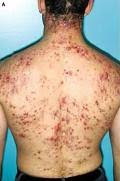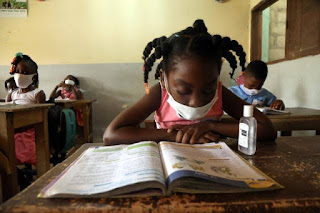Simple ways To Cure,Prevent Pimples
Pimples are a general problem , common among people of all ages . When someone has a breakout, he/she may want to know how to remove those pimples as quickly as possible.
While a person may not completely eliminate pimples in a day, he/she can make some significant improvement in shrinking blemishes and reducing redness.
The following tips can aid in treating pimples on any area of the body, but particularly meant to pimples on the face.
Treating pimples on the face
It is not advisable for any person to pick at, squeeze, or otherwise “pop” a pimple. By so doing tey can only spread the bacteria that cause acne, risking infection of the pimple, and acne scarring.
Instead, try these methods to get rid of pimples fast:
- Wash the affected spots with a gentle cleanser. Pat the area dry using a clean towel.
- Use a spot treatment that can dry out the pimple. Examples,a spot treatm- ents can include tea tree oil, benzoyl peroxide, or salicylic acid. Apply to the pimple and spots around it, using clean hands, to target the pore and oil builtup underneath.
- If a person does not have any spot treatments available, he/she can try home remedies instead. Examples of these include crushing an aspirin and mixing it into a paste with a small quantity of water. Applying calamine lotion may also allow to dry out the lesion.
- Consider specialized spot treatments or masks that you apply directly to the pimple. Examples include clay masks for acne blemishes, or acne “dots.” Acne dots are small that cover blemishes and contain drying solutions, such as tea tree oil or salicylic acid.
While a person is waiting for the pimple to disappear completely, he/she can apply a medicated concealer or cosmetic drying lotion. These contain ingredients, like salicylic acid or benzoyl peroxide, to treat the blemish further while it heals
Treating pimples on the body
Pimples on the chest and back are highly treatable but could require a different approach from facial treatments, because of variations in the skin.
Some potential treatments include:
- Using a body wash that contains benzoyl peroxide. The American Academy of Dermatology (AAD)recommend leaving the body wash on the chest or back for 2–5 minutes before rinsing. If a person has a sensitive skin, he/she can use a 5.3% benzoyl peroxide solution. Those with very oily skin can use as much as a 10% solution.
- Applying a 0.1% adapalene gel to any skin lesion spots. A person may purchase this gel over the counter. If someone cannot easily reach his/her back to apply the gel, they can buy a device to apply the medicine.
- Changing clothing immediately after exercising to reduce sweat and oil buildup. If an individual cannot bathe immediately after exercising, wiping the skin with a cleansing wipe or flannel can be helpful
- Refraining from picking or scratching pimples. Picking at pimples may make them worse and increase the risk of more severe symptoms.

- Using oil-free sunscreens when in the sun. Manufacturers sometimes label oil-free products as noncomedogenic. Using these can allow prevent oil building up under the skin.
- Always using oil- and fragrance-free lotions. Avoiding oils and fragrances on acne-prone areas of the body can reduce the chances for body acne breakouts.
As with pimples on the face, acne blemishes on the rest of the body might take time to completely clear. If a pers - on does not see results in 6–8 weeks, they can consult a dermatologist
Large or deep pimples specifically can damage the skin and lead to scarring. These acne scars may appear as lowered or raised spots of skin that will typically become more noticeable as people age and start to lose collagen fibers in their skin.
While there are treatments available for pimple scars, preventing them from occurring in the first place is the best approach. This involves caring for the skin not only when a person has a breakout but also afterward. Steps include:
- Avoiding squeezing, popping, or picking at a blemish. These approaches can lead to the damage of skin, increasing the risks for scarring.
- Maintaining a consistent skin care routine ,such as face washing, exfoliating, and applying anti-acne treatments, like retinoids, tea tree oil, or azelaic acid.
- Avoiding scrubbing the skin excessively or over exfoliating. This may cause a person’s skin to over produce oil, which can lead to further blemishes and greater risks of more acne.
- If a person cannot control their breakouts with home care and over-the-counter skin care products, they may talk to their dermatologist about prescription options
While the occasional pimple and break- out can happen to anyone, there are steps a person can take to prevent these whenever possible.
Steps include a consistent skin care routine to maintain the skin’s balance and prevent excess oil. Here are ways to help prevent pimples:
- Cleansing the skin twice daily with a soft cleanser and warm, but not hot water.
- Applying a topical agent daily that may help preventing blemishes, usually by reducing oil and improving skin cell turnover rate. Examples of topical treatments include retinol, adapalene gel, tea tree oil, benzoyl peroxide, salicylic acid, or azelaic acid.
- Applying an oil- and fragrance-free moisturizer to the skin, if necessary.
- Avoiding using heavily fragranced or oily products if a person is prone to acne.
- Changing the sheets and pillowcases at least twice a week to keep dead skin cells from piling up, as well as other bacteria, and oil that may cause acne breakouts.
- Using fragrance-free detergents to wash clothing and bedding whenever possible can reduce the risk of further breakouts.
Sometimes, if a person develops moderate to severe acne, they will require prescription treatments. These may include antibiotics to reduce the bacteria that cause acne or tretinoin, which is a prescription strength retinoid.
Some women also benefit from taking birth control pills to reduce their risks for hormonal acne.














Comments
Post a Comment